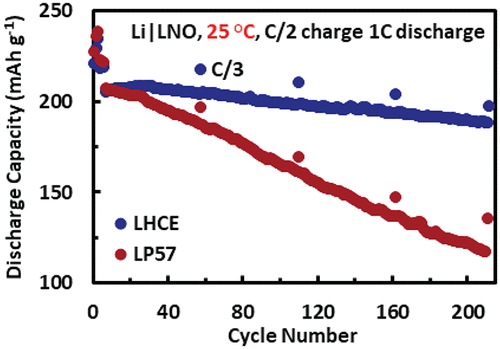当前位置:
X-MOL 学术
›
ACS Energy Lett.
›
论文详情
Our official English website, www.x-mol.net, welcomes your
feedback! (Note: you will need to create a separate account there.)
Role of Electrolyte in Overcoming the Challenges of LiNiO2 Cathode in Lithium Batteries
ACS Energy Letters ( IF 19.3 ) Pub Date : 2021-10-07 , DOI: 10.1021/acsenergylett.1c01714 Jayse Langdon 1 , Zehao Cui 2 , Arumugam Manthiram 1, 2
ACS Energy Letters ( IF 19.3 ) Pub Date : 2021-10-07 , DOI: 10.1021/acsenergylett.1c01714 Jayse Langdon 1 , Zehao Cui 2 , Arumugam Manthiram 1, 2
Affiliation

|
LiNiO2 (LNO) is a high-capacity and model cathode first discovered in the 1980s that fell out of favor due to its intrinsic instabilities. However, research activities toward LNO are once again on the rise as the push for higher-energy-density cells marches on. We demonstrate here that with appropriate modern electrolytes, major performance improvements can be achieved with LNO with no additional modifications. Cells with a localized high concentration electrolyte (LHCE) deliver 92% capacity retention after 200 cycles compared with 56% capacity retention in a baseline carbonate electrolyte, maintain 94% capacity after high-voltage storage compared with 77% capacity, and display a higher onset temperature of thermal runaway of 244 °C compared with 188 °C. These improvements are attributed to the LHCE’s high oxidative stability and its formation of fluorine-rich interphases. Although further characterization of this new class of electrolyte is necessary, this work demonstrates that modern electrolytes can be drop-in enablers of high-capacity, long-cycle-life cells.
中文翻译:

电解质在克服锂电池中LiNiO2阴极挑战中的作用
锂镍2(LNO) 是 1980 年代首次发现的高容量和模型阴极,由于其固有的不稳定性而失宠。然而,随着对更高能量密度电池的推动,对 LNO 的研究活动再次增加。我们在此证明,使用适当的现代电解质,无需额外修改即可实现 LNO 的重大性能改进。具有局部高浓度电解质 (LHCE) 的电池在 200 次循环后提供 92% 的容量保持率,而基线碳酸盐电解质中的容量保持率为 56%,在高压存储后保持 94% 的容量与 77% 的容量相比,并显示出更高的起始与 188°C 相比,热失控温度为 244°C。这些改进归因于 LHCE 的高氧化稳定性及其富氟中间相的形成。尽管需要对这种新型电解质进行进一步表征,但这项工作表明现代电解质可以成为高容量、长循环寿命电池的直接推动者。
更新日期:2021-11-12
中文翻译:

电解质在克服锂电池中LiNiO2阴极挑战中的作用
锂镍2(LNO) 是 1980 年代首次发现的高容量和模型阴极,由于其固有的不稳定性而失宠。然而,随着对更高能量密度电池的推动,对 LNO 的研究活动再次增加。我们在此证明,使用适当的现代电解质,无需额外修改即可实现 LNO 的重大性能改进。具有局部高浓度电解质 (LHCE) 的电池在 200 次循环后提供 92% 的容量保持率,而基线碳酸盐电解质中的容量保持率为 56%,在高压存储后保持 94% 的容量与 77% 的容量相比,并显示出更高的起始与 188°C 相比,热失控温度为 244°C。这些改进归因于 LHCE 的高氧化稳定性及其富氟中间相的形成。尽管需要对这种新型电解质进行进一步表征,但这项工作表明现代电解质可以成为高容量、长循环寿命电池的直接推动者。











































 京公网安备 11010802027423号
京公网安备 11010802027423号